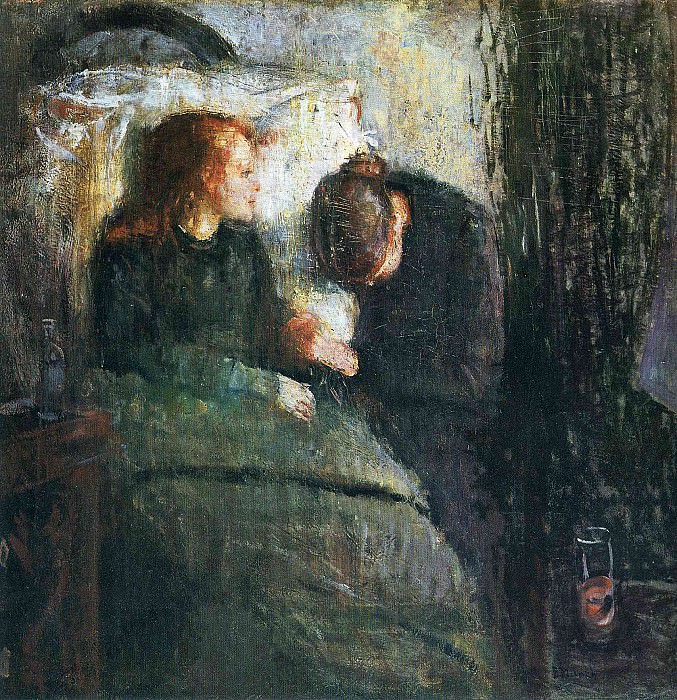Sick Girl Edvard Munch (1863-1944)
Edvard Munch – Sick Girl
Edit attribution
Download full size: 1707×1767 px (0,4 Mb)
Painter: Edvard Munch
This painting was Edvard Munch’s first masterpiece, exhibited in 1886, but it was not initially recognized. Critics and viewers blamed Munch for the unfairness of the work and for the incompleteness and crudity of the composition. In their essays, writers printed many negative and even angry reviews from viewers of the exhibition. Only half a century later, the painting was accepted by the people and became part of the art world. Munch was greatly affected by, but also inspired by, the theme of death.
Description of Edvard Munch’s painting "The Sick Girl"
This painting was Edvard Munch’s first masterpiece, exhibited in 1886, but it was not initially recognized. Critics and viewers blamed Munch for the unfairness of the work and for the incompleteness and crudity of the composition. In their essays, writers printed many negative and even angry reviews from viewers of the exhibition. Only half a century later, the painting was accepted by the people and became part of the art world.
Munch was greatly affected by, but also inspired by, the theme of death. The personal pain after the loss of his own older sister Sophie, who passed away from tuberculosis, was the impetus for him to create a painting called The Sick Girl.
The image makes the viewer feel touching and sentimental feelings. The characters in the painting are a woman of advanced years and a girl who looks ill. The woman, perhaps offering desperate prayers to heaven, holds the frail child’s hand. The girl’s bright red hair, half lying on a pillow, accentuates the unhealthy color of her skin. A slight glow emanates from her, emblematic of her imminent departure into the next world.
Although the painting has bright colors that enliven its appearance, on the whole Munch’s work makes a rather heavy impression. The many dark colors suggest tragic thoughts of imminent and approaching death.
Despite the gloominess of the room and the environment as a whole, the eyes of the sick girl do not express pain or fear. Her gaze is full of humility and serenity, perhaps she does not understand what is about to happen to her. This makes the viewer empathize with the suffering of the unfortunate patient.
Munch based the appearance of the patient in this painting on a real girl he saw by chance. She was only 11 years old, but he was struck to the core by the kindness and compassion for her ailing brother that such a young creature was capable of.
Кому понравилось
Пожалуйста, подождите
На эту операцию может потребоваться несколько секунд.
Информация появится в новом окне,
если открытие новых окон не запрещено в настройках вашего браузера.
You need to login
Для работы с коллекциями – пожалуйста, войдите в аккаунт (open in new window).




















COMMENTS: 1 Ответы
У постели больного
Жизнь идет по иному.
Глядя в очи родные,
Где страданье застыло,
От бессилья заплачешь,
Что теперь мало значишь,
Что помочь ты не можешь,
Лишь с улыбкой сквозь слёзы
Скажешь доброе слово.
А самой так хр....!
You cannot comment Why?
The painting depicts a somber scene with two figures in a dimly lit room. On the left, a young woman with reddish hair is seated, facing to the right and looking towards the second figure. She appears frail and perhaps ill, with her gaze directed away from the viewer. Her expression is difficult to discern fully due to the loose brushwork, but it suggests a sense of weariness or introspection.
To her right, a second figure, likely an older woman or a caregiver, is leaning over the seated woman. This figures head is bowed, their face obscured by shadow and their posture conveying a sense of deep concern or perhaps grief. Their hands are gently placed near the seated woman, hinting at comfort or care.
The color palette is dominated by dark, muted tones, with greens, browns, and grays creating a somber atmosphere. The lighting is dramatic, with a strong, almost harsh light illuminating the ill womans face and shoulders, contrasting with the deep shadows that envelop the rest of the scene. This play of light and shadow emphasizes the emotional weight of the moment and isolates the figures within their intimate, unsettling space.
Subtexts within the painting: